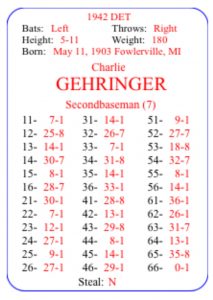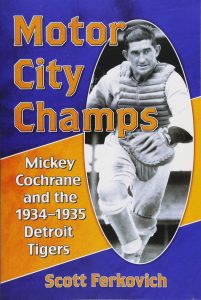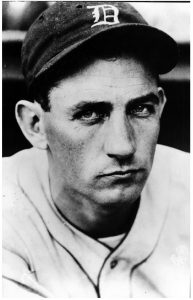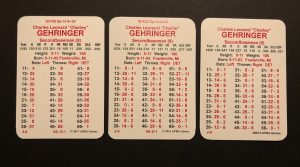
Recently, I’ve been reading Scott

As you might expect, there’s a great deal written about Hall of Famer Charlie Gehringer. Knowledgable baseball fans know Gehringer, but because of his quiet demeanor, he always seems to be under the radar when people think of the greatest second basemen.

When baseball fans think of the greatest second basemen, names like Rogers Hornsby, Eddie Collins, and Nap Lajoie usually come to mind. If you’re thinking of modern second basemen, you might think of Joe Morgan and Rod Carew. Yet, “The Mechanical Man” should be in everyone’s all-time top five second basemen. If I
My introduction to Charlie Gehringer came in
Charlie Gehringer was a six-time All-Star, but remember there was no All-Star game for the first half of Gehringer’s career. In Comiskey Park in 1933, Charlie was the first AL starting second baseman. In his 18-year career, Gehringer collected 2,839 hits for a .320 lifetime average. Plus, he had an amazing .404 lifetime on-base-percent. Gehringer led the AL in runs scored, hits, and doubles twice; triples and stolen bases once; and batting average once. When Charlie hit .371 in 1937, he was 34 years old and the oldest batting champion.
In 1940, Gehringer helped lead the Detroit Tigers to the World Series for the third time. The ‘40 campaign was his last productive season. Starting in 1941, injuries and age started taking their toll on Charlie’s performance. He only hit .220 in ‘41. In 1942, Gehringer lost the starting second baseman position and was relegated to pinch hitting duties.
Charlie Gehringer’s final APBA card looks like the late-inning pinch hitter that he was. With five 14s and four hit numbers against an A pitcher with nobody on base, this card would be a good play to hit for the pitcher in the eighth or ninth inning. For the season, Gehringer did have a respectable .365 OBP, and this card should come close to producing that number. Taking the 61-36 into consideration, I project this card to produce a .267 average…exactly what Charlie hit in 1942.
| I | Split | G | GS | PA | AB | R | H | 2B | 3B | HR | RBI | SB | BB | SO | BA | OBP | SLG | OPS | TB |
|---|---|---|---|---|---|---|---|---|---|---|---|---|---|---|---|---|---|---|---|
| 1942 Totals | 45 | 1 | 52 | 45 | 6 | 12 | 0 | 0 | 1 | 7 | 0 | 7 | 4 | .267 | .365 | .333 | .699 | 15 |
After the 1942 season, Gehringer joined the Navy and served his country during World War II. When he was discharged in 1945, he was in the best shape of his life and considered a comeback. However, at age 42, he decided his baseball playing days were behind him. During his playing days, Charlie refused to get married because his widowed mother lived with him. However, after her death, he did marry in 1953. That same year, he was inducted into the Baseball Hall of Fame, yet he missed the induction ceremony because he was on his honeymoon.

A while back, I bought the 1935 APBA Baseball season set. Currently, I’m replaying the Detroit Tigers 1968 and 1908 seasons. However, I’m nearly done with the 1968 season, and then I plan to start the 1935 Detroit Tigers season. I’m really looking forward to using Gehringer’s 1935 card. One of the things I like most about historical replays is the sense of familiarity you get from playing with a ball players card over an extended stretch of games. Not only do you feel like you understand the strengths and weaknesses of the star players, but you also feel like you understand and know the regular players. It’s the magic of APBA.




RThanks for the great article. I think I recall hearing that Charlie Gehringer played all nine innings in the first 4 All-Star games! Can you imagine the outcry today if a player was asked to play all 9 inning of an exhibition game?
One of the Tigers often overlooked on the 1934-`935 Tigers was P Elden Auker, who was 15-7 in 1934 and 18-7 in 1935. His ERAs were never that impressive, but what WAS impressive is that Auker was one of the Tigers mainstays on the mound.
It was my privilege to become acquainted with Auker, who, along with former major league C Andy Seminick, were active members of our Central Florida SABR chapter in the late ’90s and early 2000s. They regularly attended our chapter meetings and we named our chapter after them.
Auker (who pass on in 2006) was extremely complimentary of Charlie Gehringer and repeatedly stated that he though Gehringer was was of the greatest 2b of all time.
Your article on Charlie Gehringer brought back something I read in an old 60s magazine when they interviewed him at Dodgers Stadium. The interviewer asked him to compare Koufax, who was pitching that day, with Lefty Grove. Gehringer unhesitatingly replied, “Well, Grove threw much harder than Koufax.” He went on to say that Grove never threw to spots. He just threw it up there and dared you to hit it. And, until later in his career, threw few breaking pitches. He said Grove didn’t have much of a curve or slider anyway.
Now this was over 20 years after he’d retired, and he wasn’t in the batter’s box facing Koufax, but he certainly faced Grove plenty, so I don’t think you can reject his comments out of hand. If his words were true, one can only wonder just how hard Grove really threw. He certainly had plenty on the ball. He was the best pitcher in baseball by a considerable margin for several years.